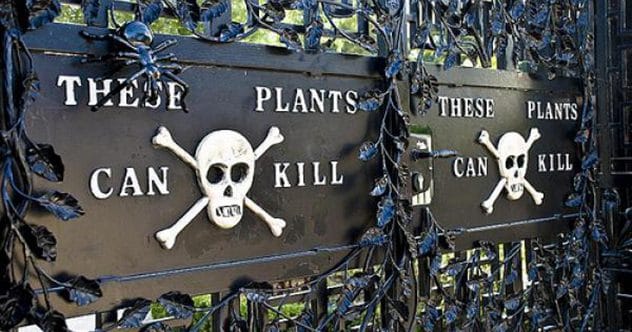Imagine your garden. Is it a peaceful spot for sunbathing and reading? Or perhaps it’s a lively place for barbecues with friends? While it might seem calm on the surface, a closer look reveals a hidden world. Down among the plants and soil, a silent war is raging. Plants, insects, and even tiny creatures are constantly fighting for survival. They use surprising tactics, including powerful chemical weapons, to claim their space and find food. Get ready to explore this secret battlefield in your own backyard!
10. Tree-Killing Fungi: Nature’s Demolition Crew
When we think of fungi, poison often comes to mind. Many mushrooms and toadstools, like the dreaded ‘Death Cap’ or ‘Satan’s Bolete’, pack a toxic punch. These poisons are clever defense mechanisms, warning animals and insects to stay away.
However, some fungi take a more active approach in their chemical warfare. Take the bracket fungus, Fomitopsis betulina, often found on birch trees. If a birch tree shows any sign of weakness, this fungus springs into action. It releases digestive enzymes that break down the tree’s internal structure. The fungus then feasts on this pre-digested material, slowly consuming the tree.
But it’s not all bad news. Some chemicals in these “brackets”—the disc-shaped growths on infected trees—are surprisingly beneficial for humans. They possess antiseptic and anti-inflammatory properties. Intriguingly, this type of fungus was discovered with a 5,000-year-old mummy in the Alps. This suggests that ancient people might have used it for medicinal purposes.
9. Fungi Using Insects as Hired Guns
Here’s another fungus that plays rough: the sac fungus (Ascomycota), notorious for attacking elm trees. This crafty fungus uses elm bark beetles as unwitting accomplices. These beetles lay their eggs in dying elm trees. If the fungus is present, its spores stick to the young beetles.
When these young beetles fly off to feed on healthy trees, they carry the fungal spores with them. The spores then invade the tree, particularly its water and nutrient transport system. This is a death sentence for the elm. Its leaves turn yellow and shrivel, and its shoots die back, a condition known as ‘Dutch elm disease’. This devastating disease, first identified in the Netherlands, has wiped out countless elm trees across Europe and North America.
But there’s a glimmer of hope. Some trees, like the European White Elm (Ulmus laevis), fight back. This elm produces a chemical called Alnulin in its bark. Elm bark beetles seem to dislike the taste or smell of Alnulin, so these trees often escape infection. It’s a fascinating example of natural chemical defenses offering a path to survival against disease.
8. The ‘Wood-Wide Web’: Fungal Social Networks
Despite the previous examples, fungi aren’t always the villains in the garden. In fact, they’re often vital allies to plants. The mushrooms you see above ground are just fruit. The real magic happens underground with a vast network of thin, root-like threads called mycelium.
This mycelial network is incredibly beneficial. It helps decompose dead leaves and wood, enriching the soil. It can even boost a tree’s immune system by prompting it to produce defensive chemicals. But recently, scientists discovered something even more amazing. This network acts like an underground internet, nicknamed the ‘wood-wide web’.
Through this web, trees can share nutrients with each other. Even more fascinating, they can send warning signals. If one plant in the network is attacked by pests like aphids, it can alert its neighbors. These connected plants then start producing their own defense chemicals to ward off the potential threat. The full extent of this complex chemical communication is still being uncovered, revealing a hidden layer of cooperation in the plant world.
7. Insect Alchemists: Masters of Chemical Weaponry
Chemical warfare in the garden isn’t just for fungi and trees. Insects are also skilled chemists, creating potent toxins to kill or annoy their enemies. Ants are a prime example. With over 12,000 species worldwide, ants have developed an impressive arsenal of chemical defenses.
Some ants have truly fearsome reputations. The bullet ant (Paraponera clavata) from Central America delivers an intensely painful sting by injecting a neurotoxin called poneratoxin. This toxin is powerful enough to cause severe pain and other neurological effects.
But you don’t need to travel to exotic jungles to find ants with chemical weapons. The common black garden ant (Lasius niger), likely found in your own backyard, uses formic acid. They can spray this irritating acid to defend their colony or subdue prey. It’s a reminder that even small creatures pack a surprising chemical punch.
6. Plants as Pharmacists: Brewing Natural Insecticides
If plants didn’t defend themselves, insects would happily munch through gardens and forests. Most plants can’t run away or fight back physically (except for a few meat-eaters like the Venus flytrap). So, it’s no surprise that many have evolved chemical defenses to protect themselves.
We all know about infamous plants like deadly nightshade and poison ivy, which contain potent toxins. But even everyday garden plants can produce chemicals toxic enough to deter insect attackers. Consider the humble mint plant. For us, it’s a source of refreshing flavor, perfect for tea or a tasty sauce.
However, from an insect’s perspective, mint is a chemical minefield. It produces a cocktail of toxic compounds. One of the most powerful is pulegone, a chemical that can damage the nervous system of creatures that ingest or come into contact with it. This shows how ordinary plants quietly wage chemical war against their tiny foes.
5. Aphids: Sweet Bribery and Ant Bodyguards
Aphids are tiny insects that gardeners often dislike. They can weaken plants by sucking their sap, damage new growth, and spread plant viruses. While aphids have natural enemies like ladybugs and wasps, their populations can sometimes explode, causing significant harm to garden plants.
These little creatures have a remarkably clever chemical tactic. They excrete a sugary liquid called honeydew, which is made from the plant sap they consume. This honeydew is a sweet treat for ants. Ants love it so much that they become fiercely protective of the aphids.
Ants have been observed fending off aphid predators. They even act as aphid farmers, carefully moving aphids from wilting plants to fresh, healthy ones to ensure their sugary food supply continues. This alliance, brokered by a sweet chemical offering, is a fascinating example of interspecies cooperation—or manipulation!
4. Turning the Tables: Plants Fight Back Against Aphids
Despite their ant allies, aphids don’t always have an easy life in the garden. Some plants have developed chemical defenses specifically against these sap-suckers. Strong-smelling plants, like garlic and onions (members of the Allium family), can deter certain aphid species.
These plants contain a complex mix of sulfur-based chemicals. It’s thought that these strong odors might confuse aphids by masking the scent of the plants they’d rather feed on. It’s like a chemical smokescreen, making it harder for aphids to find their targets.
Other plants use a different strategy. Instead of repelling aphids directly, they produce chemicals that attract aphid predators. For example, chamomile flower buds release a volatile compound that ladybugs find attractive. By luring in these natural enemies, the plant gets help in its fight against aphids. Choosing the right plants to attract these beneficial insects is a key part of natural pest control, though an ongoing area of study.
3. Spiders: Weaving Wonders with Protein Chemistry
Spiders are master architects and chemists, especially when it comes to their silk. The amazing webs they spin are made from very long protein molecules. These proteins are packed together to create strong, flexible fibers. What’s truly incredible is how spiders control the properties of their silk.
Proteins are built from smaller units called amino acids. A spider can change the mix of amino acids in a particular strand of silk. This allows them to customize their silk for different jobs. Some strands need to be incredibly tough to form the main structure of the web and hold it together.
Other strands are designed to be more stretchy and sticky. These are the ones that effectively capture unsuspecting insects that fly into the web, absorbing the impact and trapping the prey. This precise control over protein chemistry makes spider silk one of nature’s most remarkable materials.
2. Birds and Bouquets: The Scented Secrets of Nests
Seeing small birds flitting around your garden is often a welcome sight. It usually means there are plenty of insects for them to eat, helping to keep pest populations in check. For a long time, scientists believed birds relied mainly on their sharp vision and keen hearing to find food and avoid danger, largely ignoring their sense of smell.
However, recent research suggests that for some birds, the sense of smell is indeed quite important. Scientists have observed birds like starlings and blue tits carefully adding aromatic plant leaves to their nests. It’s thought they select these plants based on their smell.
But why do they do this? Are the strong scents meant to deter predators from approaching the nest? Or do the chemicals in these plants help keep harmful bacteria and parasites under control, creating a healthier environment for their chicks? The exact reasons are still being studied, revealing another layer to the chemical interactions in your garden.
1. Venomous Mammals: The Mole’s Toxic Bite
When we think of venomous creatures, snakes or spiders usually come to mind. Very few mammals produce poison, as they typically use teeth and claws to catch prey. However, there are some surprising exceptions, and one might be digging in your garden right now: the European mole.
Moles are often seen as garden pests due to their tunneling, but they also do good work like aerating the soil. We picture them as cute, furry creatures munching on earthworms. But their eating habits are more complex, and a bit gruesome. A mole’s saliva contains a toxin that can paralyze its prey, like earthworms and other bugs.
The mole then drags its still-living, immobilized prey into its underground tunnel system. There, it stores the unfortunate victims in a ‘larder’ to be eaten later. The European mole is the only one known to have this specific behavior, although certain types of shrews can also deliver venomous bites. It’s a startling reminder that even familiar garden mammals can have hidden chemical capabilities.
Your garden is more than just a pretty space. It’s a dynamic ecosystem buzzing with unseen activity. From fungi deploying digestive enzymes to plants producing their own insecticides, chemical warfare is a daily reality. Understanding these natural processes can give us a new appreciation for the complexity and resilience of life, even in the most ordinary of settings. Nature’s chemical arsenal is truly a marvel of evolution.
What’s the most surprising chemical interaction you’ve learned about in nature? Share your thoughts and garden stories in the comments below!










